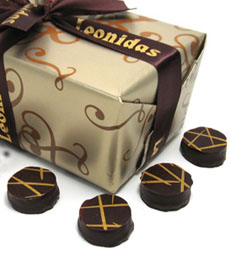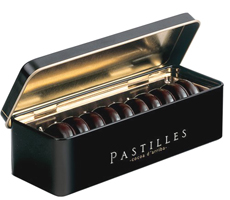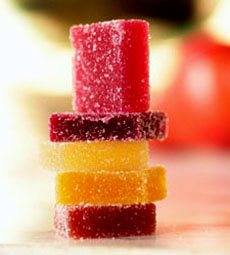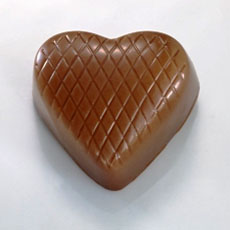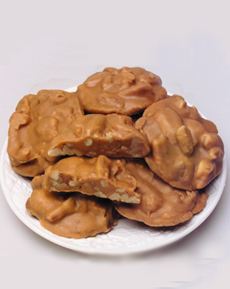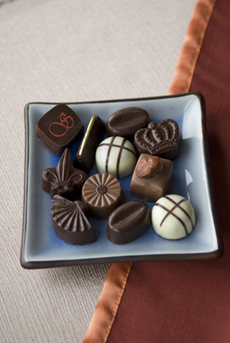 A dish of pralines, or Belgian molded chocolates, from Schocolat, a NIBBLE Top Pick Of The Week. Photo by Corey Lugg | THE NIBBLE. A dish of pralines, or Belgian molded chocolates, from Schocolat, a NIBBLE Top Pick Of The Week. Photo by Corey Lugg | THE NIBBLE.
Last Updated May 2018 |
Product Reviews / Main Nibbles / ChocolateChocolate GlossaryChocolate Terms & Definitions: P
Here page you’ll find terms including percentage of cacao, porcelana cocoa, praline, premier cru chocolate and pure origin chocolate. If you think we should consider chocolate terms and definitions other than those we have provided, click on the Contact Us link on this page. Also enjoy our many other food glossaries. Use this index bar to visit the appropriate glossary section. a b c d e f g h i j k l m n o p q r s t u v w x y z This glossary is protected by copyright and cannot be reproduced in whole or part.
PANNEDPanning is one of the four basic methods of coating chocolate onto a center (mostly hard centers such as nuts and crystallized ginger). The other methods are enrobing, panning and molding or shell molding. In panning, chocolate is sprayed onto the centers as they rotate in revolving pans; cool air is then blown into the pan to harden the chocolates. On a small scale (and before the industrial revolution), nuts are coated on a pan on the stovetop; they can be rolled in cocoa powder or other coating before they harden. PARTICLE SIZEThe basis by which chocolate smoothness is measured. The particles of the cacao beans and sugars are broken to such a small-scale microscopic magnitude that the tongue is unable to detect individual particles. Generally, particles sizes of 14-18 microns are desirable.
(1) The amount of cacao solids in a bar compared to other ingredients (e.g. sugar). Cacao is a combination of cacao mass, cocoa butter and cocoa powder. The higher the percentage of cacao in a bar, the more depth of chocolate flavor, and the less sweet the chocolate. A recipe for chocolate includes cacao, sugar, vanilla and emulsifier, plus milk if it is milk chocolate. The higher amount of cacao replaces the corresponding amount of sugar in the recipe (an average milk chocolate has about 20% milk solids, and most chocolate contains 1% vanilla and emulsifier). Thus, 70% cacao chocolate has less sugar than 60% chocolate. Cacao percentages range from 30% cacao for some milk chocolates to 100% cacao, which has no sugar but is still enjoyable by some people for eating. Cacao percentage is only one factor in taste. Other variables include the type and quality of the bean, how the beans are roasted, how the chocolate is processed, the amount and type of sugar or other sweetener, added flavorings, extra cocoa butter, etc. A higher percentage of cacao solids is not a guarantee of a better product. Good chocolate depends on the quality and origin of the beans and the manufacturer’s production techniques and blend (recipe); as well as the freshness of the chocolate. (2) According to the Chocolate Manufacturers Association, “% cacao” refers to the total percentage of ingredients (by weight) which come from the cacao bean (or cocoa bean) such as chocolate liquor, cocoa butter, and cocoa powder found in a chocolate product. (3) White chocolate has no cocoa solids (chocolate liquor): The “% cacao” refers to the cocoa butter. The higher the percentage, the creamier the white chocolate. The use of the “% cacao” designation originated in Europe, where chocolates must be labeled to indicate the minimum total cocoa solids. “Cocoa solids” are often stated as “% Cacao” (France, Spain), “% Kakao” (Germany) or “% Cocoa” (U.K.). In the U.S., chocolate manufacturers are not required to declare the percentage. However, due to the increased consumption of fine imported chocolate bars bearing the designation, and consumer interest in learning more about chocolate, a trend has begun among American producers of better chocolate to add the designation. PORCELANA
Flavors will vary by producer, but in addition to almonds, Porcelana typically yields strawberries, cream, butter, butterscotch and sometimes bread flavors. The bars tend to be a reddish-brown in color. To purchase a limited edition, 70% cacao Porcelana bar from Amedei, click here.
After retiring from the duc’s service, Lassagne founded the Maison de la Praline, a confectioner’s shop that still exists in the town of Montargis in the same location, operated by a family named Mazet. They sell pralines made with the original recipe (you can find their products online). In the centuries since, the marketplace has taken the word praline and used it to describe multiple products. Whenever you see the word praline, nuts are involved; but the word often does not refer to the original caramelized almond.
PRALINE PASTE or PRALINÉPraline paste, also called praliné (prah-lee-NAY) is a ground nut paste generally made from almonds or hazelnuts and sugar (the paste can be made from any nut; pistachio paste also is popular). It has been used in French patisserie since the 16th century to make pastries and to flavor mousse, buttercream and ice cream. Hazelnut praliné is a roasted and caramelized nut paste invented during a chocolate shortage in the 19th century in Turin, Italy. In Italy it is known as gianduja (jon-DOO-ya). It is popularly combined with chocolate and used in other confections. PREMIER CRU CHOCOLATEThe term Chocolat Michel Cluizel and some other chocolatiers use for their estate-grown chocolate. Abbreviated as 1er cru. PRESS CAKE or PRESSED CAKE or TOURTEAU DE CACAOAn interim product in the production of chocolate, that remains after most of the cocoa butter has been pressed from the chocolate liquor by using massive hydraulic pressure. The resulting press cake is later pulverized into cocoa powder. The cocoa press was invented by Coenrad Johannes Van Houten, a Dutch chemist who took out a patent for it in Amsterdam on April 4, 1828. Van Houten also invented the alkalizing process known as Dutching. PRESSINGThe stage of chocolate-making where the chocolate liquor is carried through hydraulic presses and the melted cocoa butter is extracted from the paste. PRESTIGE CHOCOLATEThe most expensive category of chocolate. In the confectionary industry, chocolate is categorized by its price per pound at retail. The categories include Mass Market, less than $15 per pound; Mass Market Premium, from $15 to $25 per pound; Gourmet, from $25 to $40 per pound; and Prestige, at $40 per pound and higher.
PUGGINGThe first rudimentary form of chocolate, after the mixture has been kneaded with the addition of vanilla, cocoa butter and (if milk chocolate) powdered milk.
PURE ORIGIN CHOCOLATEChocolate created with beans from one particular area or region. Also known as single origin chocolate.
Continue To Next Page: Terms With R Lifestyle Direct, Inc. All rights reserved. Images are the copyright of their respective owners.
|
|||||||||||||||||||||||
Last Updated May 2018
© Copyright 2005-2025 Lifestyle Direct, Inc. All rights reserved. All images are copyrighted to their respective owners.
